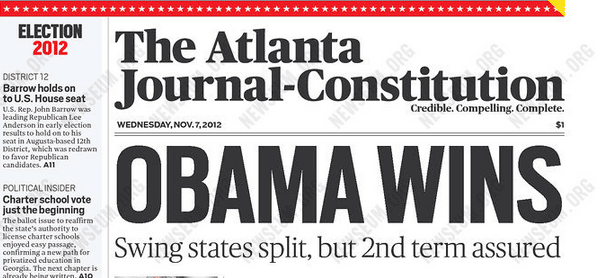The Simple Trick to Make Sure All of Your E-mails Get Read


Welcome to Newspaper 101, a brand-new series from News To Live By.
Newspaper 101 is simple: how can the content and style of the daily paper make us better writers and communicators?
The inaugural topic:
What Newspaper Headlines Teach Us About Effective E-Mail Subject Lines
Ever been to the Web site for the Newseum, DC’s media museum? Every day the Newseum displays front pages of newspapers across the country. From The New York Times to the Daily Bee in Sandpoint, Idaho, they’re all here.
Yesterday (Wednesday) was unique because virtually every US newspaper had the same story on the front page.
You guessed it: Obama re-elected president. With a sharp, concise headline, each paper catches our eye and lures us in.
Newspaper headlines were basically Twitter before social media ever existed.
For generations, editors have needed to make a big statement in as few words as possible. Up above, none of the headlines are longer than four words, but they’re all compelling. In fact, two of the three don’t even tell you what’s going on. ‘ENCORE’ and ‘BEST IS YET TO COME’ are baiting you to keep reading for the full story.
So what the heck does this have to do with your e-mail?
An inbox is a fierce jungle where e-mails vie for competition. Think how many you get on a daily basis that you either don’t read or delete immediately. Just like a newspaper article or blog post, it all comes down to the headline.
Writing a sales pitch to a potential client? Inviting a huge group of friends to a party? Submitting a cover letter that needs to stand out?
They all require strong, captivating subject lines. Your e-mail might be great, but with a so-so headline it may not get read.
Here’s what your e-mail subject needs:
– active voice (‘Obama Wins’ and not ‘The Race Was Won By Obama’)
– bold word choice when appropriate (i.e. critical, crucial, #1, best)…this article explains why we can’t stop reading Cosmo
– don’t give it all away (leave the reader thinking ‘It’s going to bug me all day if I don’t see what this e-mail is about’)
– be brief (always ask yourself: what’s the quickest way for me to say what I need to say?)
A strong e-mail heading causes readers to zero in on your message. Like a diamond in the rough, it jumps off the screen and demands attention.
Editors understand that strategy, and that’s why every single newspaper on Wednesday had a short but sweet headline announcing Obama’s big win.
In fact, the president himself followed the same advice when he declared victory on Twitter.
All he wrote:
‘Four more years’
It became the most retweeted tweet of all time.
Extra! Extra! Newspaper 101 will return soon with more lessons from the daily paper that we can apply to our own lives. Stay tuned!






Related Articles
December 17, 2014
8 Tools to Increase Your Work Productivity
An NTLB guest post from Robert Morris.
Read More
March 10, 2015
The Ten Commandments of Networking Emails
Thou shalt obey.
Read More
May 10, 2016
How to Write a Blog Post — Type 3: News Relevance
Be relevant. Gain followers.
Read More